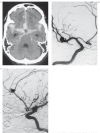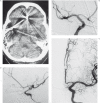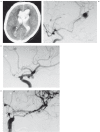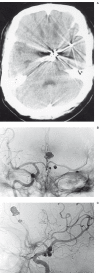Endovascular coiling of multiple (more than four) intracranial aneurysms. Case report
- PMID: 20587268
- PMCID: PMC3463384
- DOI: 10.1177/159101990401000110
Endovascular coiling of multiple (more than four) intracranial aneurysms. Case report
Abstract
The incidence of multiple intracranial aneurysms has been reported from 5% to 35%. But over four multiple aneurysms are extremely rare. Sometimes it is very difficult to draw a clear line between ruptured ones and unruptured others especially in multiple aneurysm cases with even distribution of subarachnoid haemorrhage on basal cistern. We present two cases of multiple aneurysms, more than four, which were successfully treated by endovascular coiling at the same time. Our experience suggests an endovascular procedure would be the gold standard of treatment for ruptured multiple intracranial aneurysms.
Figures




Similar articles
-
Aneurysm Characteristics, Study Population, and Endovascular Techniques for the Treatment of Intracranial Aneurysms in a Large, Prospective, Multicenter Cohort: Results of the Analysis of Recanalization after Endovascular Treatment of Intracranial Aneurysm Study.AJNR Am J Neuroradiol. 2019 Mar;40(3):517-523. doi: 10.3174/ajnr.A5991. Epub 2019 Feb 28. AJNR Am J Neuroradiol. 2019. PMID: 30819769 Free PMC article.
-
Treatment of ruptured and unruptured cerebral aneurysms in the USA: a paradigm shift.J Neurointerv Surg. 2018 Jul;10(Suppl 1):i69-i76. doi: 10.1136/jnis.2011.004978.rep. J Neurointerv Surg. 2018. PMID: 30037962
-
Endovascular Treatment of Ruptured Proximal Segment of the Anterior Cerebral Artery Aneurysms: Single-Center Experience and Literature Review.World Neurosurg. 2020 Mar;135:e237-e245. doi: 10.1016/j.wneu.2019.11.135. Epub 2019 Nov 29. World Neurosurg. 2020. PMID: 31790836
-
Ruptured carotid-ophthalmic aneurysm treatment: a non-inferiority meta-analysis comparing endovascular coiling and surgical clipping.Br J Neurosurg. 2017 Jun;31(3):345-349. doi: 10.1080/02688697.2017.1297371. Epub 2017 Mar 2. Br J Neurosurg. 2017. PMID: 28637115 Review.
-
Selection of cerebral aneurysms for treatment using Guglielmi detachable coils: the preliminary University of Illinois at Chicago experience.Neurosurgery. 1998 Dec;43(6):1281-95; discussion 1296-7. doi: 10.1097/00006123-199812000-00011. Neurosurgery. 1998. PMID: 9848841 Review.
Cited by
-
Multiple ruptured cerebral aneurysms at the National Hospital of the Kyrgyz Republic between 2008 and 2014: a departmental summary.Nagoya J Med Sci. 2019 Aug;81(3):511-518. doi: 10.18999/nagjms.81.3.511. Nagoya J Med Sci. 2019. PMID: 31579341 Free PMC article.
References
-
- Ellamushi HE, Grieve JP, et al. Risk factors for formation of multiple intracranial aneurysms. J Neurosurg. 2001;94:728–732. - PubMed
-
- Inagawa T. Surgical treatment of multiple intracranial aneurysms. Acta Neurochir (Wien) 1991;108:22–29. - PubMed
-
- Juvela S. Risk factors for multiple intracranial aneurysms. Stroke. 2000;31:392–397. - PubMed
-
- Kaminogo M, Yonekura M, Shibata S. Incidence and outcome of multiple intracranial aneurysms in a defined population. Stroke. 2003;34:16–21. - PubMed
-
- Kong CB, Huh JT, Jo CM. Risk factors for formation of multiple intracranial aneurysms. J Korean Neurosurg Soc. 2002;32:23–28.
LinkOut - more resources
Full Text Sources

